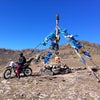Melbourne Airport (IATA: MEL, ICAO: YMML), colloquially known as Tullamarine airport, is the primary airport serving the city of Melbourne, and the second busiest airport in Australia. It was opened in 1970 to replace the nearby Essendon Airport. Melbourne Airport is the sole international airport of the four airports serving the Melbourne metropolitan area.
The airport is 23 km (14 mi) from the city centre. The airport has its own postcode—Melbourne Airport, Victoria (postcode 3045). This is adjacent to the suburb of Tullamarine.
The Melbourne–Sydney air route is the fourth most-travelled passenger air route in the world. The airport features direct flights to 33 domestic destinations and to destinations in the Pacific, Europe, Asia and North America. Melbourne Airport is the number one arrival/departure point for the airports of four of Australia's seven other capital cities. Melbourne serves as a major hub for Qantas and Virgin Australia, while Jetstar Airways and Tiger Airways Australia utilise the airport as home base. A regular coach service provides public transport to and from the city. Melbourne is the busiest airport for international export freight as of August 2011, while second busiest for import freight. Domestically, Melbourne serves as headquarters for Australian air Express and Toll Priority and handles more domestic freight than any other airport in the nation.
In 2003, Melbourne received the International Air Transport Association Eagle Award for service and two National Tourism Awards for tourism services. This increased to 33.1 million passengers per annum by July 2015.
Before the opening of Melbourne Airport, Melbourne's main airport was Essendon Airport which was officially designated an international airport in 1950. In the mid-1950s, over 10,000 passengers were using Essendon Airport and the limitations of Essendon Airport were beginning to become apparent. Essendon Airport's facilities were insufficient to meet the increasing demand for air travel; the runways were too short to handle the then new jet airliners and the terminals failed to handle the increase in passengers, by the mid-1950s, an international overflow terminal was built in a new northern hangar. Due to the encroachment of the urban boundary, the airport had become surrounded by residential housing, meaning that expansion of Essendon Airport was not possible.
The search for a replacement for Essendon commenced in February 1958, when a panel was appointed to assess Melbourne's civil aviation needs.
In 1959 the Commonwealth Government acquired 5,300 ha (13,000 acres) of grassland in then-rural Tullamarine.
In May 1959 it was announced that a new airport would be built at Tullamarine, with Prime Minister Robert Menzies announcing on 27 November 1962 a five-year plan to provide Melbourne with a A$45 million "jetport" by 1967. The first sod at Tullamarine was turned two years later in November 1964.
On 1 July 1970, Melbourne Airport was opened to international operations by Prime Minister John Gorton, ending Essendon's near 2-decade run as Melbourne's international airport. Essendon still was home to domestic flights for one year, until they were transferred to Melbourne Airport on 26 June 1971, with the first arrival of a Boeing 747 occurring later that year.
Melbourne Airport was originally called 'Melbourne International Airport'. It is at Tullamarine, a name derived from the indigenous name Tullamareena. By the late 1980s peak passenger flows at the airport had reached 900 per hour, causing major congestion.
Australian Airlines aircraft at Melbourne Airport in 1988.]]
In 1988, the Australian Government formed the Federal Airports Corporation (FAC), placing Melbourne Airport under the operational control of the new corporation along with 21 other airports around the nation. Melbourne Airport was included in the first phase, being acquired by the newly formed Australia Pacific Airports Corporation Limited for $1.3 billion. Melbourne Airport is categorised as a Leased Commonwealth Airport.
In July 1997, the Melbourne Airport website was launched, providing Australia's first real-time flight operations data over the internet. Work on an upgrade of the international terminal commenced in 1991,
Since privatisation, further improvements to infrastructure have begun at the airport, including expansion of runways, car parks and terminals. The multi-storey carpark outside the terminal was completed between 1995 and August 1997 at a cost of $49 million, providing 3,100 parking spaces, the majority undercover. Expansion of the Qantas domestic terminal was completed in 1999, featuring a second pier and 9 additional aircraft stands.
Expansion of carparks has also continued with a $40 million project commenced in 2004, doubling the size of the short term carpark with the addition of 2,500 spaces over six levels, along with 1,200 new spaces added to the 5,000 already available in the long term carpark. Revenue from retail operations at Melbourne Airport broke the $100 million mark for the first time in 2004, this being a 100 per cent increase in revenue since the first year of privatisation. The works were followed in March 2006 by a 5,000 m2 (54,000 sq ft) expansion of Terminal 2, and the construction of an additional level of airline lounges above the terminal. In 2008 a further 25,000 m2 (270,000 sq ft) expansion of Terminal 2 commenced, costing $330 million with completion in 2011. The works added 5 additional aerobridges on a new passenger concourse, and a new 5,000 m2 (54,000 sq ft) outbound passenger security and customs processing zone.
Airport Layout
Melbourne Airport's terminals have 56 gates: 40 domestic and 16 international. There are five dedicated freighter parking positions on the Southern Freighter Apron. The current terminal numbering system was introduced in July 2005; they were previously known as Qantas Domestic, International, and South (formerly Ansett Domestic).
Terminal 1 hosts domestic and regional services for Qantas Group airlines, Qantas and QantasLink (which is located to the northern end of the building). Departures are located on the first floor, while arrivals are located on the ground floor. The terminal has 16 parking bays served by aerobridges; 12 are served by single aerobridges whilst four are served by double aerobridges. There are another five non-aerobridge gates, which are used by QantasLink.
Opened with Melbourne Airport in 1970 for Trans Australia Airlines, the terminal passed to Qantas in 1992 when they acquired the airline. Work on improving the original terminal commenced in October 1997 and was completed in late 1999 at a cost of $50 million,
link= | This article needs to be updated. (July 2014) |
T2 International Terminal T2 Departure Gates Terminal 2 handles all international, and limited domestic, flights out of Melbourne Airport, and was opened in 1970. The terminal has 20 gates with aerobridges. Cathay Pacific, Malaysia Airlines, Qantas (which includes two lounges in Terminal 2, a First lounge and a Business lounge/Qantas Club), Singapore Airlines, Air New Zealand, Etihad Airways and Emirates all operate airline lounges in the terminal.
The international terminal contains works by noted Australian Indigenous artists including Daisy Jugadai Napaltjarri and Gloria Petyarre.
A$330 million expansion programme for Terminal 2 was announced in 2007 and was completed in 2012. The objectives of this project include new lounges and retail facilities, a new satellite terminal, increased luggage capacity and a redesign of customs and security areas. A new satellite terminal features floor-to-ceiling windows offers views of the North-South runway. The new concourse includes three double-decker aerobridges which are gates 16, 18 and 20, each accommodating an A380 aircraft or two smaller aircraft and one single aerobridge. The baggage handling capacity will be increased, and two new baggage carousels will cater to increased A380 traffic. Work commenced in November 2007 and will be completed in 2011 but was opened in 2012.
Although described as a satellite terminal, the terminal building is connected by an above-ground corridor to Terminal 2. Departures take place on the lower deck (similar to the A380 boarding lounges currently in use at Gates 9 and 11), with arrivals streamed on to the first floor to connect with the current first floor arrivals deck. All gates including 18 and 20 are now handling passengers.
Gate 13 used by Virgin Australia at T3
Terminal 3 opened with the airport as the Ansett Australia terminal, but is now owned by Melbourne Airport. Terminal 3 is home to Virgin Australia. It has eleven parking bays served by single aerobridges and eight parking bays not equipped with aerobridges.
An expansion of the terminal was approved in 1989 and completed in 1991 when a second pier was added by Ansett to the south for use by smaller regional airline Kendell. As a result, Melbourne Airport undertook a major renovation and facelift of the terminal, following which Virgin Australia (then Virgin Blue) moved in from what was then called Domestic Express (now Terminal 4), and has since begun operating The Lounge in the terminal, using the former Ansett Australia Golden Wing Lounge area. Regional Express also operates an airline lounge in the terminal. The second pier of T3 was lost to the new T4, out of the ten gates they will be reclaiming three. While the others will be owned By Tigerair Australia. Check-In facilities for Virgin Australia will still be in T3.
Terminal 4 – originally called the Domestic Express or South Terminal – is dedicated to budget airlines and is the first facility of its kind at a conventional airport in Australia. It was originally constructed for Virgin Blue (Virgin Australia) and Impulse Airlines. Virgin Blue eventually moved into Terminal 3 following the demise of Ansett. A$5 million refit began in June 2007 along the lines of the budget terminal model at Singapore Changi Airport and Kuala Lumpur International Airport. Lower landing and airport handling fees are charged to airlines due to the basic facilities, lack of jet bridges, and fewer amenities and retail outlets compared to a conventional terminal. However, the terminal is located next to the main terminal building, unlike in Singapore and Kuala Lumpur. The terminal was rebuilt by Tiger Airways Australia, which has used it as its main hub since it operated its first domestic flight on 23 November 2007.
Jetstar Airways confirmed its involvement in discussions with Melbourne Airport regarding the expansion of terminal facilities to accommodate for the growth of domestic low-cost services. The expansion of Terminal 4 includes infrastructure to accommodate Tiger Airways Australia and Jetstar Airways flights. The development cost hundreds of millions of dollars. In March 2012 it was announced that in October the same year T4 is to break ground, an expected completion of July 2014 was released, but was pushed back to late August 2015 and opened on 18 August 2015. The new T4 terminal is 35,000 m2 (380,000 sq ft) and linked "under one roof" with T3. Terminal 4 is currently used by Tigerair Australia, Regional Express Airlines, Jetstar and Airnorth. In November 2015 Jetstar moved into T4.Three Gates are dedicated to Virgin Australia. Currently the Tigerair Australia Peir is not fully complete, while they are building it there is a makeshift walkway to the gates. Jetstar has triple the amount of gates they had at T1.
The Southern Freighter Apron has five dedicated freighter parking positions which host 21 dedicated freighter operations a week. Holiday Inn has an outlet located 400 m (1,300 ft) from the terminal precinct. Ibis Budget offers lodgings located 600 m (2,000 ft) from the terminals. Mantra Tullamarine opened in 2009, 2 km (1.2 mi) from the terminal precinct.
Melbourne Airport terminal precinct Melbourne is the second busiest airport in Australia. The airport is curfew-free and operates 24 hours a day, although between 2 am and 4 am, freight aircraft are more prevalent than passenger flights. In 2004, the environmental management systems were accredited ISO 14001, the world's best practice standard, making it the first airport in Australia to receive such accreditation.
Construction works were undertaken to prepare the airport for the arrival of the double-decker Airbus A380. The A380 has been purchased by several airlines using the airport, namely Malaysia Airlines, Qantas, Qatar Airways, Thai Airways, China Southern Airlines, Singapore Airlines, Etihad Airways and Emirates. The improvements included the construction of dual airbridges (Gates 9 and 11) with the ability to board both decks simultaneously to reduce turnaround times, the widening of the North-South runway and remote stands and taxiways by 15 m (49 ft), the extension of the international terminal building by 20 m (66 ft) to include new penthouse airline lounges, and the construction of an additional baggage carousel in the arrivals hall. As a result, the airport was the first in Australia to be capable of handling the A380. The A380 made its first test flight into the airport on 14 November 2005. On 15 May 2008 the A380 made its first passenger flight into the airport when a Singapore Airlines Sydney-bound flight was diverted from Sydney Airport because of fog.
Beginning services in October 2008, Qantas was the first airline to operate the A380 from the airport, flying nonstop to Los Angeles International Airport twice a week. This was the inaugural route for the Qantas A380.
Melbourne Airport has two intersecting runways: one 3,657 m (11,998 ft) north–south and one 2,286 m (7,500 ft) east–west. Due to increasing traffic, several runway expansions are planned, including an 843 m (2,766 ft) extension of the north-south runway to lengthen it to 4,500 m (14,764 ft), and a 1,214 m (3,983 ft) extension of the east–west runway to a total of 3,500 m (11,483 ft). Traffic movement is expected to reach 248,000 per annum by 2017, necessitating a third runway.
On 5 June 2008, it was announced that the airport would install a Category III landing system, allowing planes to land in low visibility conditions, such as fog. This system will be the first of its kind in Australia, and was commissioned March 2010 at a cost of $10 million. The airport is also the home of the Canberra approach and Melbourne approach facilities, which provide control services to aircraft arriving and departing at those airports.
| Airlines | Destinations |
|---|---|
| AirAsia X | Kuala Lumpur–International |
| Aircalin | Nouméa |
| Air Canada | Seasonal: Vancouver (begins 3 December 2017) |
| Air China | Beijing–Capital, Shanghai–Pudong, Shenzhen (ends 30 July 2017) |
| Air India | Delhi |
| Airnorth | Toowoomba–Brisbane West Wellcamp |
| Air New Zealand | Auckland, Christchurch, Queenstown, Wellington |
| Alliance Airlines | Charter: Uluru/Ayers Rock, Sydney |
| Beijing Capital Airlines | Qingdao, Shenyang |
| Cathay Pacific | Hong Kong |
| China Airlines | Taipei–Taoyuan Seasonal: Christchurch |
| China Eastern Airlines | Shanghai–Pudong |
| China Southern Airlines | Guangzhou, Shenzhen |
| Emirates | Auckland, Dubai–International, Singapore |
| Etihad Airways | Abu Dhabi |
| Fiji Airways | Nadi |
| Garuda Indonesia | Denpasar, Jakarta–Soekarno–Hatta |
| Hainan Airlines | Changsha, Xi'an |
| Japan Airlines | Tokyo–Narita (begins 2 September 2017) |
| Jetstar Airways | Adelaide, Auckland, Ayres Rock, Ballina, Bangkok–Suvarnabhumi, Brisbane, Cairns, Christchurch, Darwin, Denpasar, Gold Coast, Ho Chi Minh City , Hobart, Honolulu, Launceston, Newcastle, Osaka–Kansai, Perth, Phuket, Proserpine, Queenstown, Singapore, Sunshine Coast, Sydney, Townsville |
| LATAM Chile | Santiago de Chile (begins 6 October 2017) |
| Malaysia Airlines | Kuala Lumpur–International |
| Philippine Airlines | Manila |
| Qantas | Adelaide, Alice Springs, Auckland, Brisbane, Broome, Cairns, Canberra, Christchurch, Darwin, Dubai–International (ends 23 March 2018), Gold Coast, Hamilton Island, Canberra, Hobart, Sydney (begins 4 August 2017) Seasonal: Launceston, Sunshine Coast |
| QantasLink operated by Eastern Australia Airlines | Canberra, Devonport, Launceston, Mildura Seasonal: Kingscote (begins 17 December 2017) |
| Qatar Airways | Doha |
| Regional Express Airlines | Albury, Burnie–Wynyard, King Island, Merimbula, Mildura, Mount Gambier, Wagga Wagga |
| Royal Brunei Airlines | Bandar Seri Begawan |
| Scoot | Singapore |
| Sichuan Airlines | Chengdu |
| Singapore Airlines | Singapore |
| SriLankan Airlines | Colombo (resumes 30 October 2017) |
| Thai Airways | Bangkok–Suvarnabhumi |
| Tianjin Airlines | Chongqing (begins 1 November 2017) |
| Tigerair Australia | Adelaide, Brisbane, Cairns, Canberra, Coffs Harbour, Gold Coast, Hobart, Perth, Sydney, Townsville |
| United Airlines | Los Angeles |
| Vietnam Airlines | Ho Chi Minh City |
| Virgin Australia | Adelaide, Auckland, Brisbane, Cairns, Canberra, Christchurch, Darwin, Gold Coast, Hamilton Island, Hobart, Hong Kong, Kalgoorlie–Boulder, Launceston, Los Angeles, Mildura, Nadi, Newcastle, Perth, Sunshine Coast, Sydney |
| XiamenAir | Xiamen |
The following airlines operate cargo-only services from Melbourne Airport's Southern Freighter Apron:
| Airline | Destinations |
|---|---|
| Australian airExpress | Adelaide, Brisbane, Cairns, Canberra, Gold Coast, Hobart, Launceston, Perth, Sydney, Townsville |
| Cathay Pacific Cargo | Hong Kong, Sydney, Toowoomba–Brisbane West Wellcamp |
| MASkargo | Kuala Lumpur–International, Jakarta–Soekarno–Hatta, Sydney |
| Polar Air Cargo | Cincinnati, Hong Kong, Honolulu, Sydney |
| Singapore Airlines Cargo | Adelaide, Auckland, Singapore |
| Toll Aviation | Sydney–Bankstown |
| Toll Priority | Brisbane, Perth, Sydney |
| Toll Priority operated by Toll Aviation |
Adelaide, Brisbane, Sydney |
Melbourne Airport recorded more than 29.9 million passengers in 2012–13. 6.2 million of those were international, with the remaining 21.7 million being domestic. There were 206,798 aircraftmovements, the vast majority being domestic passenger services. In the long term, the compounded average annual growth rate (CAAGR) for passengermovements is between 3.3% and 4.3%. For aircraftmovements, the CAAGR is between 1.8% and 2.6%.
! Year || Passengers || Aircraft
movements
|-
! 1997–98
|13,791,467 || 138,252
|-
! 1998–99
|14,131,213 || 141,560
|-
! 1999–00
|15,146,129 || 150,657
|-
! 2000–01
|16,881,010 || 174,663
|-
! 2001–02
|15,967,430 || 147,150
|-
! 2002–03
|16,382,298 || 146,751
|-
! 2003–04
|18,630,612 || 157,524
|-
! 2004–05
|20,274,457 || 176,038
|-
! 2005–06
|21,040,864 || 175,435
|-
! 2006–07
|22,156,871 || 176,112
|-
! 2007–08
|23,943,342 || 186,431
|-
! 2008–09
|24,448,325 || 189,011
|-
! 2009–10
|25,917,992 || 192,641
|-
! 2014–15
|32,052,000 || unknown
|-
|}
| style="width:50%; text-align:left; vertical-align:top;" |
| Rank | Airport | Freight tonnes handled | % change |
|---|---|---|---|
| 1 | Singapore, Singapore-Changi | 47,127.8 | Increase2.9 |
| 2 | Hong Kong, Hong Kong | 35,334.1 | Increase3.5 |
| 3 | New Zealand, Auckland | 26,736.1 | Increase21.3 |
| 4 | Malaysia, Kuala Lumpur International | 22,002.2 | Decrease27.6 |
| 5 | Thailand, Bangkok-Suvarnabhumi | 20,354.9 | Increase4.1 |
| 6 | United Arab Emirates, Dubai | 18,070.9 | Increase15.7 |
| 7 | Qatar, Doha | 9,328.9 | Increase102.9 |
| 8 | People's Republic of China, Shanghai–Pudong | 5,097 | Increase34.7 |
| 9 | United States, Los Angeles | 4,877.4 | Decrease13.5 |
| 10 | Indonesia, Denpasar | 2,547.8 | Decrease17.6 |
|}</div>
|
|
Tullamarine Freeway at the Calder Freeway turnoff Melbourne Airport is 23 km (14 mi) from the city centre and is accessible via the Tullamarine Freeway. One freeway offramp runs directly into the airport grounds, and a second to the south serves freight transport, taxis, buses and airport staff. In June, 2015, the Airport Drive extension was completed, creating a second major link to the airport. The link starts at the M80 Western Ring Road and provides direct access to Melrose Drive 1.5 kilometres from the terminal area. Melbourne Airport has five car parks, all of which operate 24 hours a day, 7 days a week. The short-term, multi-level long-term, business and express carparks are covered, while the long-term parking is not. The main multi-level carpark in front of the terminal was built in the late 1990s, replacing the pre-existing ground-level car parking. as a frequent local bus service.
There are nine other bus companies serving the airport, with services to Ballarat, Bendigo, Dandenong, Frankston, Mornington Peninsula, Geelong, Melbourne's suburbs, Shepparton and the Riverina. These provide alternatives to transfer onto V/Line services.
There is currently no railway connection between the airport and the city.
The possibility of installing a rail link from what was originally known as the Broadmeadows Line (now the Craigieburn Suburban Line) to the airport was debated in the 1960s under the Bolte State Government, but with not enough support shown in parliament, the project was abandoned.
In 2001, the Bracks State Government investigated the construction of a heavy rail link to the airport under the Linking Victoria programme. Two options were considered; the first branched off the Craigieburn Suburban Line to the east, and the second branched off the Albion Goods Line, which passes close to the airport's boundary to the south. The second option was preferred. Market research concluded most passengers preferred travelling to the airport by taxi or car, and poor patronage of similar links in Sydney and Brisbane cast doubt on the viability of the project. This led to the project being deferred until at least 2012. On 21 July 2008, the Premier of Victoria reaffirmed the government's commitment to a rail link and said that it would be considered within three to five years. To maximise future development options, the airport is lobbying for the on-grounds section of the railway to be underground.
In 2010, Martin Pakula of the Labor Party, newly appointed State Minister for Public Transport announced that the rail link had been taken off the agenda with new freeway options being explored instead, however a change of government at the 2010 Victorian State Election to Liberals, saw policy for the introduction of the rail link return to the agenda, with a promise by the incoming Coalition government to undertake planning for its construction.
Proposals in January 2013 to improve the bus service to the airport involving turning emergency lanes into bus lanes on the freeway and the Bolte Bridge and putting SkyBus on a myki fare, were challenged by CityLink operator Transurban, because it would limit its toll revenue, and by Melbourne Airport, because it would reduce its car parking profits. Similar objections would apply to a rail link.
On 13 March 2013, the Victorian Liberal government under the newly installed Premier, Denis Napthine, announced that the Melbourne Airport Rail Link (MARL) would be constructed sometime in the future running from the CBD via Sunshine station and the Albion–Jacana railway line.
Melbourne Airport has received numerous awards. The International Air Transport Association ranked Melbourne among the top five airports in the world in 1997 and 1998 and, in 2003, presented it with the Eagle Award. The Australian Airport Association named it the Airport of the Year in 1999, and in the top five for airports that handle between 15 and 25 million passengers.
The airport has received recognition in other areas. It has won national and state tourism awards, and Singapore Airlines presented the airport with the Service Partner Award and Premier Business Partner Award in 2002 and 2004, respectively. In 2006, the airport won the Australian Construction Achievement Award for the runway widening project, dubbed "the most outstanding example of construction excellence for 2006". Most recently Melbourne Airport was awarded by Skytrax for having the best Airport hotel in the Australia/Pacific in the WORLD AIRPORT AWARDS. Melbourne Airport was also ranked the 43rd best airport for 2012.
| link= | Wikimedia Commons has media related to Melbourne Airport. |
| link= | Wikivoyage has a travel guide for Melbourne Airport. |





